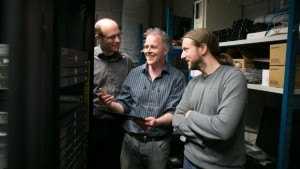Believe it or not, there are more COBOL transactions everyday than there are Google searches — 200 times more.
The venerable old programming language is now more than 50 years old, but it hangs around in places such as financial trading, airline booking systems and other dark recesses where service oriented architectures, virtualisation and cloud computing have yet to penetrate.
“The reality is that there is a lot of old software out there which is still at the heart of many critical applications, particularly in the area of financial transactions. For example, more than 50 years after the COBOL language was invented, the stark fact is that there are 200 times more COBOL transactions daily than Google searches,” commented Professor Brian Fitzgerald, Chief Scientist, Lero.
Which is why Lero has said that it has won industry commitments of more €400,000 for software modernisation programmes.
Lero researcher Dr Jim Buckley of the Computer Science & Information Systems Department at the University of Limerick, said these systems grow into old age because “they are so crucial they are often the company’s flagship products”.
Buckley said that elongated maintenance has meant that legacy software can become a sticking point for transformation projects when business innovation demands faster evolution of these systems.
“The failure of RBS and Ulster Bank ATMs in the summer of 2012 are examples of what can happen when you try to maintain such ageing software,” said Dr Buckley.
The situation is being exacerbated by an aging COBOL staff worldwide, as few coming into the industry have the deep knowledge required, while those with the skills are either moved up the line, or retiring altogether.
Lero cites a Computerworld survey of 357 IT professionals from 2012 that found almost half (46%) of respondents said they are already noticing a COBOL programmer shortage. Half said the average age of their COBOL staff is 45 or older and nearly a quarter (22%) said the age is 55 or older.
“On the one hand, you want to preserve the essential functionality and value of the product despite fast-paced modernisation,” said Dr Goetz Botterweck, an expert in Model-driven Software Engineering at Lero. “On the other hand, there is a lot of technical detail which programmers are unsure of — so you are looking for a means to separate ‘the chaff from the wheat’, getting rid of the outdated parts. However, due to the complexity of the system and hidden dependencies it is difficult to foresee the impact of a change. And the fact that often, the only up-to-date ‘documentation’ is the system itself does not help.”
“Lero research provides a way to deal with these increasingly difficult challenges for many companies,” said Dr Buckley. “We can make changes less risky and can plot a roadmap to modernise the system rather than exacerbate the problem.”
The services that Lero offers in its software modernisation activities focus primarily on two scenarios: firstly, re-positioning software into Service Oriented Architectures by identifying self-contained units of functionality in existing systems for separation into services; and secondly, by offering companies facilities to ensure that the software they create adheres to their original design.
This latter approach, says Lero, being successfully trialled on the software systems of several leading financial services companies resident in Ireland.
TechCentral Reporters







Subscribers 0
Fans 0
Followers 0
Followers